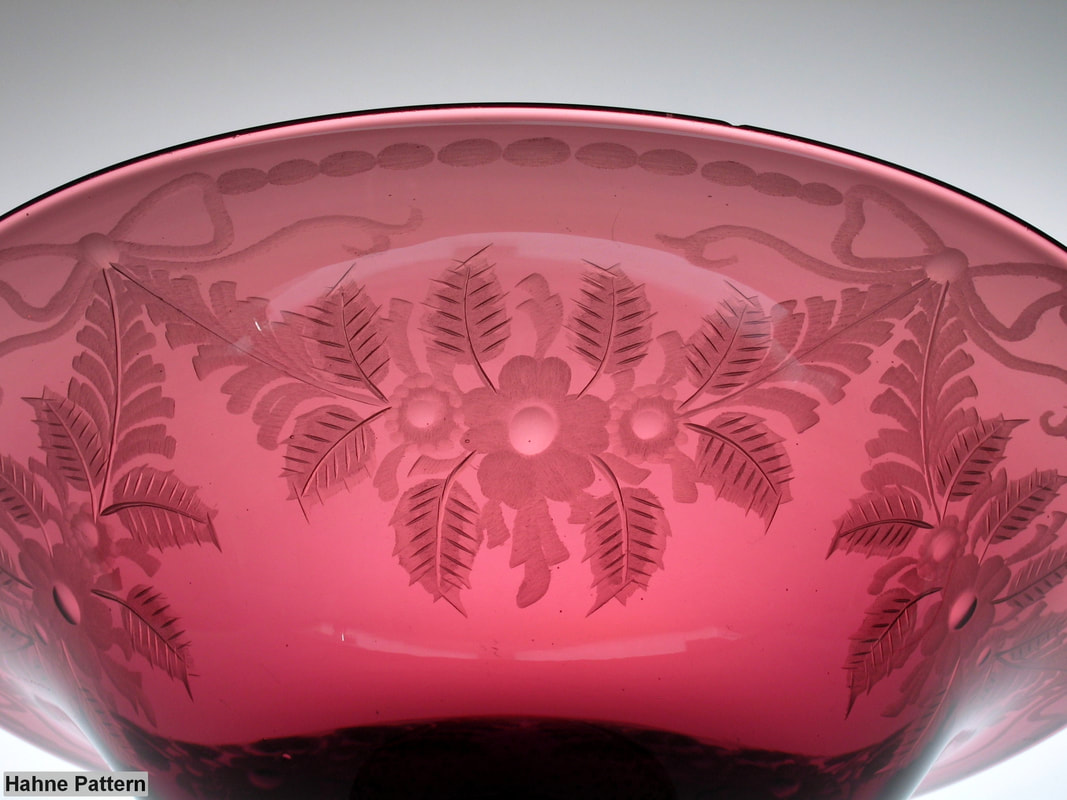For more than twenty years, documentation of this engraving pattern has eluded us. We find examples of this pattern on numerous Pairpoint shapes that appear to have been made from the latter part of the Middle Period (1930s) into the Gundersen-era (1938-1952); most of those examples are on shapes more closely associated with Gundersen. Every example of this pattern we have seen has been on an amethyst blank.
Yesterday we received a pattern identification inquiry from one of our website visitors. During our conversation, mention was made by our visitor about the bowtie feature being used by Hawkes. The “light bulb” went off in my head; I pulled out my Hawkes reference books and almost immediately found the pattern on a liquor set.
This pattern was designed and stone-engraved by Joseph Hahne, an engraver who worked for no other glass company than Hawkes. Mr. Hahne had been an engraver in Corning since WW1, but from the 1930s until his death in 1944, he only worked for Hawkes from his home studio. It is well documented that Hawkes acquired many of their blanks from Pairpoint. Given the fact that his employment with Hawkes spanned the Pairpoint to Gundersen transition years, it is easy to explain why so many Gundersen shapes are found with Hahne’s pattern.
To be consistent with my own standard, I think items found with this pattern should be attributed to Hawkes; they purchased the blanks from Pairpoint or Gundersen and finished them for sale. However, we are keeping the attribution, for identification purposes, within our Pairpoint system; in this case the shape will be the primary identifier for most collectors. Since no official name is known, we have chosen to describe this pattern as the HAHNE PATTERN.
Marion Frost
January 24, 2021
Yesterday we received a pattern identification inquiry from one of our website visitors. During our conversation, mention was made by our visitor about the bowtie feature being used by Hawkes. The “light bulb” went off in my head; I pulled out my Hawkes reference books and almost immediately found the pattern on a liquor set.
This pattern was designed and stone-engraved by Joseph Hahne, an engraver who worked for no other glass company than Hawkes. Mr. Hahne had been an engraver in Corning since WW1, but from the 1930s until his death in 1944, he only worked for Hawkes from his home studio. It is well documented that Hawkes acquired many of their blanks from Pairpoint. Given the fact that his employment with Hawkes spanned the Pairpoint to Gundersen transition years, it is easy to explain why so many Gundersen shapes are found with Hahne’s pattern.
To be consistent with my own standard, I think items found with this pattern should be attributed to Hawkes; they purchased the blanks from Pairpoint or Gundersen and finished them for sale. However, we are keeping the attribution, for identification purposes, within our Pairpoint system; in this case the shape will be the primary identifier for most collectors. Since no official name is known, we have chosen to describe this pattern as the HAHNE PATTERN.
Marion Frost
January 24, 2021

 RSS Feed
RSS Feed